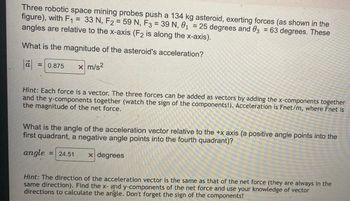Three robotic space mining probes push a 134 kg asteroid, exerting forces (as shown in the figure), with F₁ = 33 N, F2 = 59 N, F3 = 39 N, 0₁ = 25 degrees and 3 = 63 degrees. These angles are relative to the x-axis (F2 is along the x-axis). What is the magnitude of the asteroid's acceleration? |ā| = 0.875 x m/s² Hint: Each force is a vector. The three forces can be added as vectors by adding the x-components together and the y-components together (watch the sign of the components!). Acceleration is Fnet/m, where Fnet is the magnitude of the net force. What is the angle of the acceleration vector relative to the +x axis (a positive angle points into the first quadrant, a negative angle points into the fourth quadrant)? angle = 24.51 x degrees Hint: The direction of the acceleration vector is the same as that of the net force (they are always in the same direction). Find the x- and y-components of the net force and use your knowledge of vector directions to calculate the angle. Don't forget the sign of the components!
Three robotic space mining probes push a 134 kg asteroid, exerting forces (as shown in the figure), with F₁ = 33 N, F2 = 59 N, F3 = 39 N, 0₁ = 25 degrees and 3 = 63 degrees. These angles are relative to the x-axis (F2 is along the x-axis). What is the magnitude of the asteroid's acceleration? |ā| = 0.875 x m/s² Hint: Each force is a vector. The three forces can be added as vectors by adding the x-components together and the y-components together (watch the sign of the components!). Acceleration is Fnet/m, where Fnet is the magnitude of the net force. What is the angle of the acceleration vector relative to the +x axis (a positive angle points into the first quadrant, a negative angle points into the fourth quadrant)? angle = 24.51 x degrees Hint: The direction of the acceleration vector is the same as that of the net force (they are always in the same direction). Find the x- and y-components of the net force and use your knowledge of vector directions to calculate the angle. Don't forget the sign of the components!
Oh no! Our experts couldn't answer your question.
Don't worry! We won't leave you hanging. Plus, we're giving you back one question for the inconvenience.
Submit your question and receive a step-by-step explanation from our experts in as fast as 30 minutes.
You have no more questions left.
Message from our expert:
Our experts need more information to provide you with a solution.
Figure is missing.
Please resubmit your question, making sure it's detailed and complete. We've credited a question to your account.
Your Question:

Transcribed Image Text:Three robotic space mining probes push a 134 kg asteroid, exerting forces (as shown in the
figure), with F₁ = 33 N, F2 = 59 N, F3 = 39 N, 0₁ = 25 degrees and 3 = 63 degrees. These
angles are relative to the x-axis (F2 is along the x-axis).
What is the magnitude of the asteroid's acceleration?
|ā| = 0.875 x m/s²
Hint: Each force is a vector. The three forces can be added as vectors by adding the x-components together
and the y-components together (watch the sign of the components!). Acceleration is Fnet/m, where Fnet is
the magnitude of the net force.
What is the angle of the acceleration vector relative to the +x axis (a positive angle points into the
first quadrant, a negative angle points into the fourth quadrant)?
angle = 24.51 x degrees
Hint: The direction of the acceleration vector is the same as that of the net force (they are always in the
same direction). Find the x- and y-components of the net force and use your knowledge of vector
directions to calculate the angle. Don't forget the sign of the components!
Knowledge Booster
Learn more about
Need a deep-dive on the concept behind this application? Look no further. Learn more about this topic, physics and related others by exploring similar questions and additional content below.Recommended textbooks for you

Physics for Scientists and Engineers: Foundations…
Physics
ISBN:
9781133939146
Author:
Katz, Debora M.
Publisher:
Cengage Learning

Principles of Physics: A Calculus-Based Text
Physics
ISBN:
9781133104261
Author:
Raymond A. Serway, John W. Jewett
Publisher:
Cengage Learning

Glencoe Physics: Principles and Problems, Student…
Physics
ISBN:
9780078807213
Author:
Paul W. Zitzewitz
Publisher:
Glencoe/McGraw-Hill

Physics for Scientists and Engineers: Foundations…
Physics
ISBN:
9781133939146
Author:
Katz, Debora M.
Publisher:
Cengage Learning

Principles of Physics: A Calculus-Based Text
Physics
ISBN:
9781133104261
Author:
Raymond A. Serway, John W. Jewett
Publisher:
Cengage Learning

Glencoe Physics: Principles and Problems, Student…
Physics
ISBN:
9780078807213
Author:
Paul W. Zitzewitz
Publisher:
Glencoe/McGraw-Hill

Physics for Scientists and Engineers, Technology …
Physics
ISBN:
9781305116399
Author:
Raymond A. Serway, John W. Jewett
Publisher:
Cengage Learning
